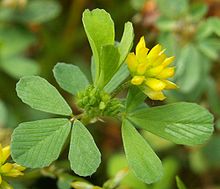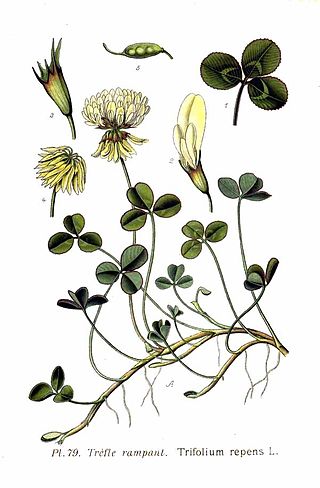
Clover, also called trefoil, are plants of the genus Trifolium, consisting of about 300 species of flowering plants in the legume family Fabaceae originating in Europe. The genus has a cosmopolitan distribution with highest diversity in the temperate Northern Hemisphere, but many species also occur in South America and Africa, including at high altitudes on mountains in the tropics. They are small annual, biennial, or short-lived perennial herbaceous plants, typically growing up to 30 centimetres (12 in) tall. The leaves are trifoliate, with stipules adnate to the leaf-stalk, and heads or dense spikes of small red, purple, white, or yellow flowers; the small, few-seeded pods are enclosed in the calyx. Other closely related genera often called clovers include Melilotus and Medicago.

A shamrock is a type of clover, used as a symbol of Ireland. Saint Patrick, one of Ireland's patron saints, is said to have used it as a metaphor for the Christian Holy Trinity. The name shamrock comes from Irish seamróg, which is the diminutive of the Irish word seamair and simply means "young clover".

Trifolium repens, the white clover, is a herbaceous perennial plant in the bean family Fabaceae. It is native to Europe, including the British Isles, and central Asia and is one of the most widely cultivated types of clover. It has been widely introduced worldwide as a forage crop, and is now also common in most grassy areas of North America, Australia and New Zealand. The species includes varieties often classed as small, intermediate and large, according to height, which reflects petiole length. The term 'white clover' is applied to the species in general, 'Dutch clover' is often applied to intermediate varieties, and 'ladino clover' is applied to large varieties.
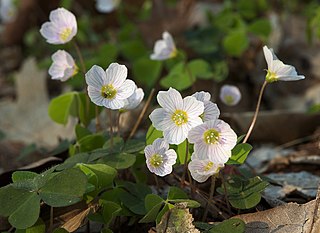
Oxalis acetosella, the wood sorrel or common wood sorrel, is a rhizomatous flowering plant in the family Oxalidaceae, common in most of Europe and parts of Asia. The specific epithet acetosella refers to its sour taste. The common name wood sorrel is often used for other plants in the genus Oxalis. In much of its range it is the only member of its genus and hence simply known as "the" wood sorrel. While common wood sorrel may be used to differentiate it from most other species of Oxalis, in North America, Oxalis montana is also called common wood sorrel. It is also known as Alleluia because it blossoms between Easter and Pentecost, when the Psalms which end with Hallelujah are sung.
Hop-clover is a common name for several different plants and may refer to:

Trifolium aureum, known by the various common names large hop trefoil, large trefoil, large hop clover, golden clover or hop clover, is a species of flowering plant native to much of Eurasia.

Trifolium campestre, commonly known as hop trefoil, field clover and low hop clover, is a species of flowering plant native to Europe and western Asia, growing in dry, sandy grassland habitats, fields, woodland margins, roadsides, wastelands and cultivated land. The species name campestre means "of the fields".

Medicago lupulina, commonly known as black medick, nonesuch, or hop clover, is a plant of dry grassland belonging to the legume or clover family. Plants of the genus Medicago, or bur clovers, are closely related to the true clovers (Trifolium) and sweet clover (Melilotus). Like the true clovers, black medick has three leaflets and a small, yellow flower closely resembling those of lesser trefoil. Black medick belongs to the same genus as alfalfa.
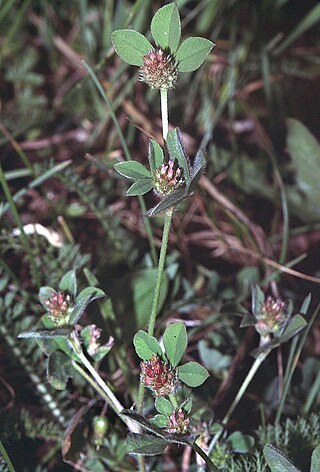
Trifolium striatum, the knotted clover, soft trefoil, is a flowering plant species in the pea and bean family Fabaceae.

Trifolium trichocalyx is a species of clover known by the common name Monterey clover.
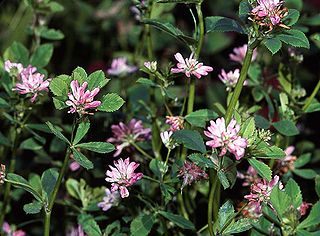
Trifolium resupinatum is an annual clover used as fodder and hay, which reaches 60 cm (24 in) tall when cultivated, and forms rosettes when grazed or mowed. It is native to central and southern Europe, the Mediterranean, and southwest Asia as far south as the Punjab. It is an important hay crop in cold regions of Iran, Afghanistan and other Asian areas with cold winters.
British NVC community OV2 is one of the open habitat communities in the British National Vegetation Classification system. It is one of six arable weed and track-side communities of light, less-fertile acid soils.

Trifolium angustifolium is a species of clover known by the common names narrowleaf crimson clover, narrow clover and narrow-leaved clover.

Trifolium depauperatum is a species of clover known by the common names cowbag clover, poverty clover, and balloon sack clover.

Trifolium glomeratum is a species of clover known by the common names clustered clover and bush clover. It is native to Eurasia and North Africa and it is known elsewhere as an introduced species. It easily takes hold in disturbed areas, becoming a common weed. It is an annual herb growing decumbent to upright in form with mostly hairless herbage. The leaves are made up of oval leaflets up to 1.2 centimeters in length. The inflorescences occur in leaf axils, each a headlike cluster of many flowers. Each flower has a calyx of sepals with triangular points that bend outward, and a pink corolla.
Trifolium gracilentum is a species of clover known by the common names pinpoint clover and slender clover. It is native to western North America including the west coast of the United States and northwestern Mexico, where it grows in many types of habitat, including disturbed areas. It is an annual herb growing prostrate to erect in form with mostly hairless or slightly hairy herbage. The leaves are made up of lance-shaped to oval leaflets. The inflorescence is an umbel of flowers that spread out or flex downward. The flowers have pink or purple corollas less than a centimeter long.

Trifolium microcephalum is a species of clover known by the common names smallhead clover and small-headed clover.

Trifolium pannonicum is a species of clover known by the common name Hungarian Clover.
Trifolium micranthum, the slender trefoil or slender hop clover, is a plant species of the genus Trifolium in the "pea family" ; Fabaceae or Papillionaceae.
